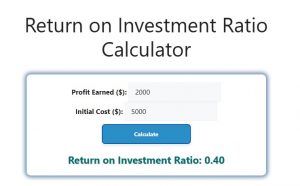About Return on Investment Ratio Calculator (Formula)
In the world of finance, understanding the performance of investments is crucial for both individuals and businesses. One of the most vital metrics used to evaluate investment success is the Return on Investment (ROI) ratio. This ratio helps investors determine how effectively their money is being utilized. By calculating the ROI, you can gauge the profitability of your investments and make informed financial decisions.
Formula
The formula for calculating the Return on Investment Ratio (ROIR) is:
ROIR = P / C
Where:
- P is the profit generated from the investment.
- C is the cost of the investment.
How to Use
To use the Return on Investment Ratio Calculator effectively, follow these steps:
- Identify the Investment Cost: Determine the total cost incurred to make the investment, including purchase price, associated fees, and any other relevant expenses.
- Calculate Profit: Calculate the profit generated from the investment. This includes any revenues earned or financial gains achieved due to the investment.
- Apply the Formula: Use the ROIR formula to divide the profit by the investment cost. This will yield a ratio that indicates the effectiveness of your investment.
- Interpret the Result: A higher ROI ratio signifies a more profitable investment, while a lower ratio indicates less effective use of resources.
Example
Let’s say you invest $5,000 in a small business. After a year, you earn $2,000 in profit from this investment.
Using the ROIR formula:
- P (profit) = $2,000
- C (cost) = $5,000
So, ROIR = 2,000 / 5,000 = 0.4 or 40%
This result indicates that for every dollar invested, you gained 40 cents in profit.

FAQs
- What is a good ROI ratio? A good ROI ratio varies by industry, but generally, an ROI of 15% or more is considered favorable.
- How often should I calculate my ROI? It’s advisable to calculate ROI regularly, especially after significant investments or at the end of each financial period.
- Does ROI include taxes? Ideally, ROI calculations should consider net profits after tax to provide a more accurate representation of investment performance.
- Can I calculate ROI on non-monetary investments? Yes, ROI can also be applied to non-monetary investments like time or effort, although quantifying these may be more challenging.
- What factors can affect my ROI? Market conditions, investment duration, and operational efficiency can all impact your ROI.
- Is a negative ROI bad? Yes, a negative ROI indicates that the investment has lost money, which is generally not desirable.
- How can I improve my ROI? To improve ROI, focus on reducing costs, increasing revenue, and selecting higher-performing investments.
- What’s the difference between ROI and ROE? ROI measures the profitability of an investment relative to its cost, while Return on Equity (ROE) measures the profitability relative to shareholders’ equity.
- Can I compare ROI across different investments? Yes, comparing ROI across similar investments can help you assess performance, but ensure they are in the same industry for a fair comparison.
- What if my investment doesn’t generate immediate profit? It’s essential to evaluate the long-term potential of the investment, as some may take time to yield profits.
- Are there any limitations to ROI? Yes, ROI doesn’t account for the time value of money or risk factors, which are crucial for a comprehensive analysis.
- How do I factor in ongoing expenses into my ROI? Include any ongoing operational costs or maintenance fees in your investment cost when calculating ROI.
- What tools can I use to calculate ROI? Many online calculators and spreadsheet software can help simplify the ROI calculation process.
- Can I use ROI for personal finance? Absolutely! ROI can help you evaluate personal investments, such as education or property.
- How does inflation affect ROI? Inflation can erode purchasing power, making it essential to factor in inflation-adjusted returns when evaluating ROI.
Conclusion
The Return on Investment Ratio Calculator is a vital tool for evaluating the effectiveness of your financial decisions. By understanding how to calculate and interpret the ROI ratio, you can make informed choices that lead to greater profitability and success in your investments. Regularly assessing your ROI ensures that you are on the right track and helps you optimize your financial strategies for the future.